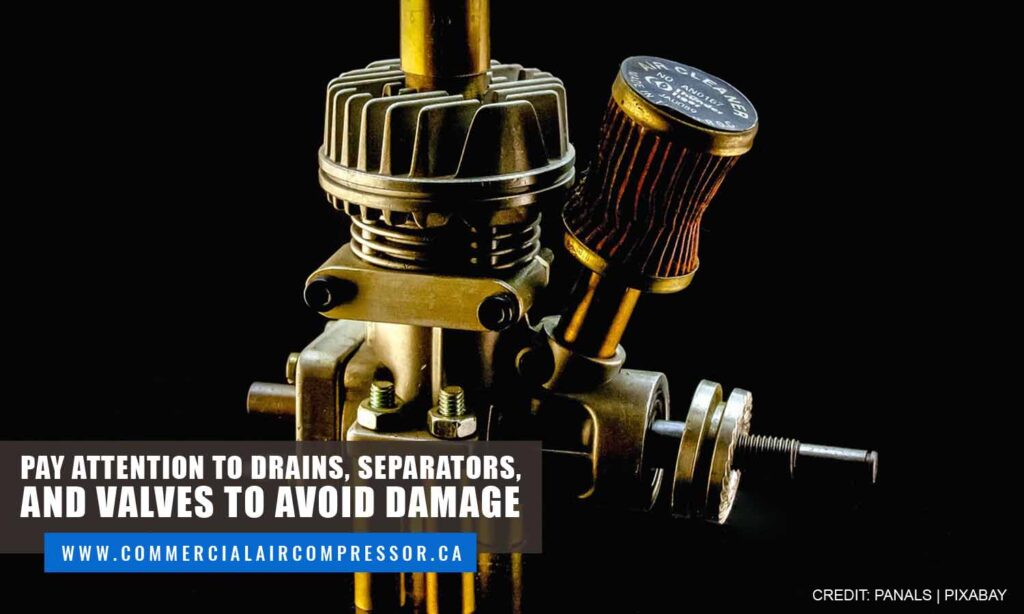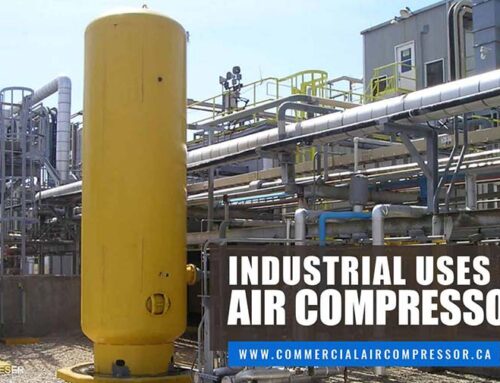
Winter’s upon us now, and that means it’s time to start prepping for the colder months. Dealing with the cold is a common air compressor problem many businesses have to face. The low temperatures can wreak havoc on industrial air compressors unless you take some steps to protect them. All air compressors naturally produce condensate as part of the compression process. However, when the liquid freezes, it can start to impede the system’s normal functions.
Winterize your air compressor now to preserve its lifespan and keep it at optimal functionality this winter. Here’s a list of steps you can take to winter-proof your compressor and protect it from the cold.

1. Check the receiver tanks for moisture
Remember to place the task of emptying the receiver tanks on your winter preparation checklist. The receiver tanks’ job is to serve as a reservoir of air for peak use and to remove water from the system as the air cools. However, in winter that water can freeze. Frozen moisture can disrupt a compressor’s regular operation and slow down production until you resolve the issue. Excess moisture in the system can also cause other problems with the compressor’s inner workings like corrosion.
Conduct regular inspections of the receiver tanks each week to make sure moisture doesn’t build up. Once you detect any water in the system, use dehumidifying and drying equipment to avoid any damage to the components. For maximum condensate collection, install drains on the tanks at a low angle as a convenient way of removing all that water. Some systems that drain themselves automatically also feature test buttons so you can test for condensation issues yourself. In case you notice large amounts of moisture appearing within a few days, contact air compressor repair services right away. The excess moisture may point to an underlying problem in the system.

2. Keep up with maintenance
Regular maintenance is typically the ideal method of looking after your system and ensuring it operates at peak efficiency. If you are running your system in extremely low temperatures, consistent weather-conscious servicing becomes critical. Inspect your system thoroughly for any issues that may affect its performance. Leaks in particular can drastically reduce the efficiency of your air compressor. A typical compressor with unattended leaks can lose up to 30% of its power and efficiency. In winter, it’s vital your system maintain peak efficiency to adjust for the higher energy demands.
Checking for leaks before winter is a great money- and energy-saving technique you can use to keep your compressor system in good condition. The cold weather can also affect the compressor’s lubricants. As it gets colder, the lubricant thickens and becomes less effective. The thickened lubricant also takes more power to pump through the system, which can put a strain on its inner components. Thickening also impedes flow, which can starve the compressor’s moving parts of lubricant and add to wear and tear.
Finally, check your drains, separators, and valves. These areas are prime locations for moisture to build up, which can also reduce the compressor’s efficiency. Check these areas for frozen condensate and clean them to ensure efficient operation. Make sure there’s no standing moisture after cleaning so no ice forms when you’re done.
3. Adjust the louvres
Proper compressor operation requires a particular temperature to ensure the lubricants spread out evenly through the machine. As the temperature changes, cold air can seep in through the louvres and affect its performance.
Adjust your louvres to minimize the amount of cold air that seeps in to lower the operating temperature. These adjustments also help keep the ambient moisture out of the oil circuit and inner workings where it could affect the machine’s performance. For added efficiency, you can also adjust the louvres to direct the compressor’s heat toward the room. Not only is it a great way to heat the surrounding environment and keep the ambient temperature high, but it can also help keep your heating bills under control.

4. Set up some heaters
Insulating homes and businesses is always a great way to retain heat during the colder months. Ideally, your compressor should be set up in a heated and insulated compressor room to maintain a high-enough temperature. Ambient temperature plays a major role in maintaining the compressor through the long winter months. Like a car, cold starts can wreak havoc on a compressor’s inner workings. Setting up heaters in critical areas nearby can augment the ambient temperature in the room. A heater can keep the lubricant temperature above the minimum, which helps reduce wear and tear on your compressor. Shop around for ambient heaters to minimize the strain on the system and help prevent system failure. Ideally, your room temperature should go no lower than 5°. When installing your heater, adjust it for the lowest allowable operating temperature recommended by the manufacturer.

5. Apply heat trace tape
Like home plumbing, it often pays to prepare outdoor equipment for the colder months by insulating exposed sections like the outdoor drains and bowls. Electric heating technology can be an effective solution to keeping your machines warm.
One tip for winterizing your air compressors is applying heat trace tape to those exposed areas of the drain line. Keep in mind that trace tape needs a power supply to operate. If you’re shutting down for the holidays, there won’t be a need for the tape as it can’t get power if the system isn’t running. In those cases, remember to drain the water from the drain line to avoid freezing damage, just like you normally do with your exterior home faucets. Another way to make the most of trace tape is augmenting your indoor heaters. Set up the heat trace tape on vulnerable pipes to keep them warm and ice-free.
6. Assess your weather stripping
Adding some weather stripping is another way you can give your exposed elements, some additional protection this winter. Weather stripping works as an insulator, keeping heat inside so your air compressor maintains optimal performance even when it gets cold. However, weather stripping tends to wear away over time, requiring a replacement.
Inspect your weather stripping before the cold weather strikes to ensure you’re prepared when it does. Replacing any worn weather stripping is a simple, inexpensive task that more than pays off when winter well and truly comes. While you’re at it, make a habit of marking your calendar to give yourself enough time to prepare. Ideally, you should perform inspections twice a year, in late fall and late spring. These inspections help prepare your compressed air system for the high highs and low lows of summer and winter.

At Commercial Air Compressor, we’re all about providing reliable and effective service for your compressed air needs. We offer a wide range of services and quality service to help you make the most of your industrial air compressors. Give us a call now at (905) 415-7744 for 24/7 support for air compressors in Ontario you can count on.
Commercialconnected with or engaged in or sponsored by or used in commerce or commercial enterprisesMore (Definitions, Synonyms, Translation)










